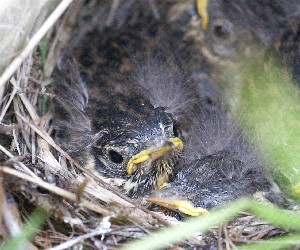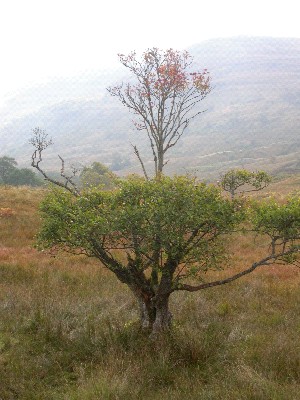|
|
The Glen Finglas Grazing Experiment What we have found
Vegetation structure, though not composition, has responded rapidly to the start of the grazing treatments in 2003. By 2007, as expected, the ungrazed treatment IV contained the tallest vegetation. However the most variable vegetation height was in the mixed grazing treatment III. This is most likely due to the impact of cow hooves on the ground and the different way in which cows and sheep graze.
Changes in the vegetation have been reflected in invertebrate populations. The largest invertebrate biomass is now found in treatment IV with the lowest in treatment I (Dennis et al. 2008). However the responses are not the same for all invertebrate groups. Work on moths has shown the reduced grazing treatment II to contain a similar abundance and species richness to treatment IV (Littlewood 2008).
 As the most abundant insectivorous upland bird, the Meadow Pipit has been studied for responses at the higher end of the food chain. An early finding was that pipits nesting in the reduced grazing treatments II and III laid larger eggs than in either the commercially grazed treatment I or ungrazed treatment IV (Evans et al. 2005b). Their breeding density is also highest in the reduced mixed grazing treatment III (Evans et al. 2006b). It seems likely that this is because the heterogeneous vegetation structure of these reduced grazing treatments makes it easier for pipits to find their invertebrate prey (Douglas et al. in press). Thus adult birds are better nourished and require a smaller territory. The experimental set-up has also provided an environment in which to examine aspects of pipit ecology that may have significant implications in a changing climate (Evans et al. 2005a; Walsh et al. 2007). As the most abundant insectivorous upland bird, the Meadow Pipit has been studied for responses at the higher end of the food chain. An early finding was that pipits nesting in the reduced grazing treatments II and III laid larger eggs than in either the commercially grazed treatment I or ungrazed treatment IV (Evans et al. 2005b). Their breeding density is also highest in the reduced mixed grazing treatment III (Evans et al. 2006b). It seems likely that this is because the heterogeneous vegetation structure of these reduced grazing treatments makes it easier for pipits to find their invertebrate prey (Douglas et al. in press). Thus adult birds are better nourished and require a smaller territory. The experimental set-up has also provided an environment in which to examine aspects of pipit ecology that may have significant implications in a changing climate (Evans et al. 2005a; Walsh et al. 2007).
Our work has also found that other vertebrates may show responses to grazing treatments. Field Voles are reduced in number by low intensity grazing (Evans et al. 2006a). At high population levels voles can cause significant damage to young trees. This indicates that a cessation of grazing may be undesirable wherever an increase in woodland cover is a management aim.
 The Glen Finglas experiment is producing mounting evidence that current and future potential grazing scenarios might produce very different Scottish upland landscapes. Whilst a commercial stocking density of sheep has an impoverished biodiversity, a cessation of livestock grazing may be detrimental to some elements of the ecosystem. Reduced grazing levels maximise the foraging efficiency of nesting pipits whilst also being beneficial for the re-establishment of woodland cover. Each of these scenarios may have implications for ecosystem services provided by such environments through contributions to water quality and carbon storage and this is the subject of future planned research. The Glen Finglas experiment is producing mounting evidence that current and future potential grazing scenarios might produce very different Scottish upland landscapes. Whilst a commercial stocking density of sheep has an impoverished biodiversity, a cessation of livestock grazing may be detrimental to some elements of the ecosystem. Reduced grazing levels maximise the foraging efficiency of nesting pipits whilst also being beneficial for the re-establishment of woodland cover. Each of these scenarios may have implications for ecosystem services provided by such environments through contributions to water quality and carbon storage and this is the subject of future planned research.
References
- Dennis, P., Skartveit, J., Mccracken, D.I., Pakeman, R.J., Beaton, K., Kunaver, A. & Evans, D.M. (2008) The effects of livestock grazing on foliar arthropods associated with bird diet in upland grasslands of Scotland. Journal of Applied Ecology, 45, 279-287.
- Douglas, D.J.T., Evans, D.M. & Redpath, S.M. (in press) Selection of foraging habitat and nestling diet by Meadow Pipits Anthus pratensis breeding on intensively grazed moorland. Bird Study.
- Evans, D.M., Redpath, S.M., Elston, D.A., Evans, S.A., Mitchell, R.J. & Dennis, P. (2006a) To graze or not to graze? Sheep, voles, forestry and nature conservation in the British uplands. Journal of Applied Ecology, 43, 499-505.
- Evans, D.M., Redpath, S.M. & Evans, S.A. (2005a) Seasonal patterns in the productivity of Meadow Pipits in the uplands of Scotland. Journal of Field Ornithology, 76, 245-251.
- Evans, D.M., Redpath, S.M., Evans, S.A., Elston, D.A. & Dennis, P. (2005b) Livestock grazing affects the egg size of an insectivorous passerine. Biology Letters, 1, 322-325.
- Evans, D.M., Redpath, S.M., Evans, S.A., Elston, D.A., Gardner, C.J., Dennis, P. & Pakeman, R.J. (2006b) Low intensity, mixed livestock grazing improves the breeding abundance of a common insectivorous passerine. Biology Letters, 2, 636-638.
- Littlewood, N.A. (in press) Grazing impacts on moth diversity and abundance on a Scottish upland estate. Insect Conservation and Diversity.
- Walsh, P.T., Evans, D.M., Hansell, M. & Ruxton, G.D. (2007) Factors influencing nocturnal egg-turning frequency in Meadow Pipits Anthus pratensis. Bird Study, 54, 133-136.
Contact: Dr. Nick Littlewood |
|